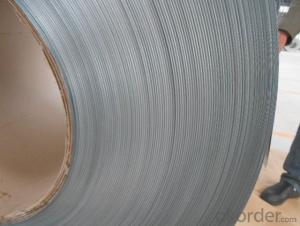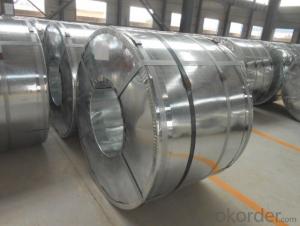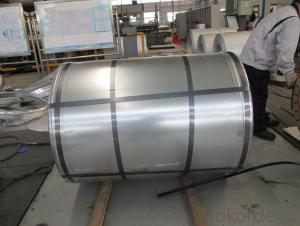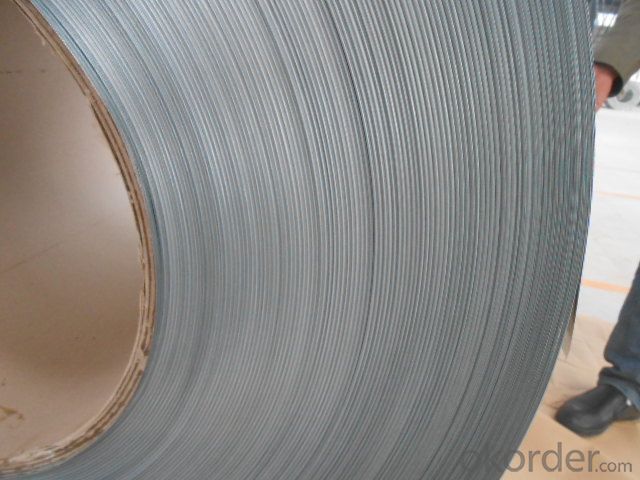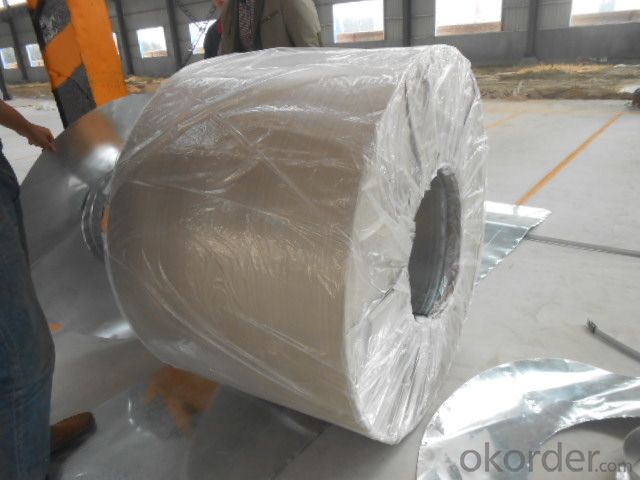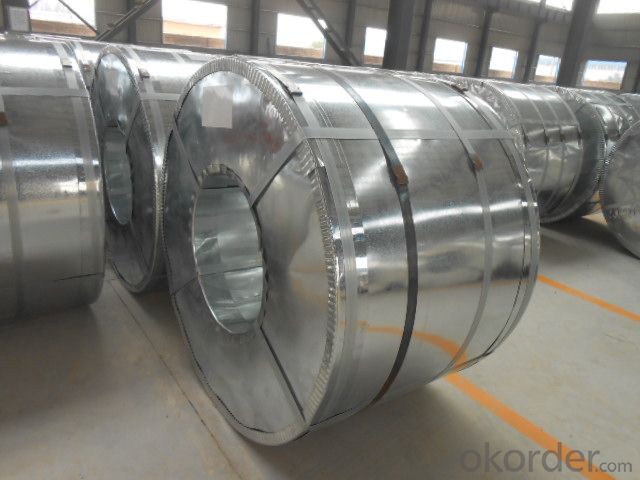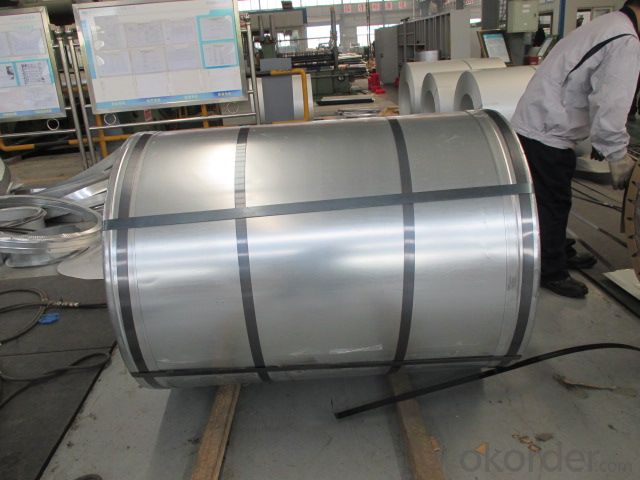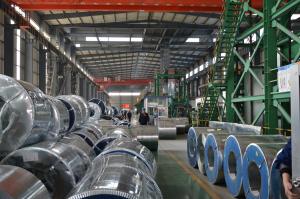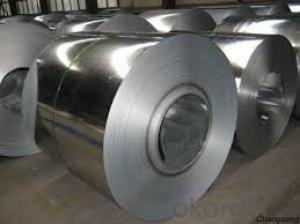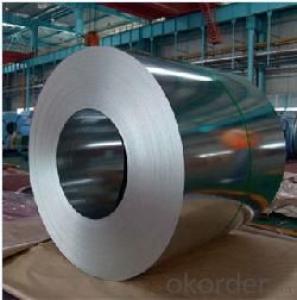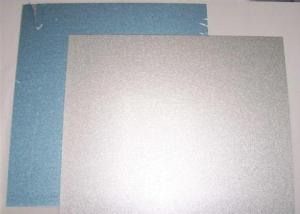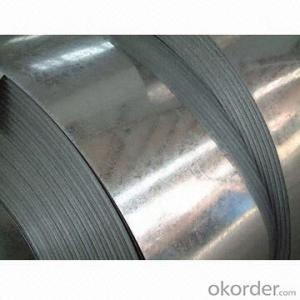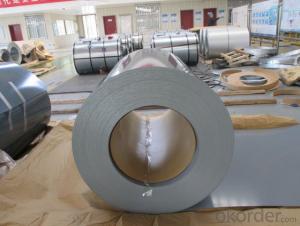galvanized steel coil Z06
- Loading Port:
- China Main Port
- Payment Terms:
- TT OR LC
- Min Order Qty:
- -
- Supply Capability:
- -
OKorder Service Pledge
OKorder Financial Service
You Might Also Like
Galvanized steel coil
Packaging & Delivery
Packaging Detail: seaworthy export package
Delivery Detail: on request
Specifications
1. more than 10 years’ experience on this field
2. advanced equipments
3. competitive price
4. soonest delivery
Product Description :
Prime Galvanized steel coil
Packaging & Delivery
Packaging Detail: seaworthy export package
Delivery Detail: on request
Specifications
1. more than 10 years’ experience on this field
2. advanced equipments
3. competitive price
4. soonest delivery
Product Description :
Commodity
Hot dip galvanized steel coil
Technical Standard:JIS 3302 / ASTM A653 / EN10143/ GB/T 2518
Grade:DX51D/ S250,280,320GD,SGCC,SGHC,SGH340,SGH400,SGH440,G450,G550
Types:Commercial / Drawing / Deep Drawing / Structural quality
Width: 900mm/1000mm/1219mm/1200mm/1220mm/1250mm
Thickness: 0.2mm~4.0mm
Type of coating: galvanized
Zinc coating: Z40-275g/m2,Z40-Z450g/m2
Surface treatment:zero spangle / regular spangle/ big spangle
ID coil: 508mm or 610mm
Coil weight: 3-10/MT per coil
Package:Properly packed for ocean freight exportation in 20''container
Application::home appliances, constructions, building, machineries
Our Advantages :
1. Expertise:
More than 10 years of manufacture: we know how to properly handle every step of production.
2. Competitive price:
We can offer competitive prices to our customers.
3. Accuracy:
We have excellent technicians and leaders, which can ensure our products are exactly what you want.
4. Materials:
All galvanized steel coils are made of high-quality raw materials.
5. Certificate:
Our products are certified by ISO9001.
6. Productivity:
We have large-scales of production lines,, which can guarantee all your orders will be finished in earliest time.
Hr CGL Technical Process:
Coil loading-> uncoiling-> cutting-> welding-> entry accumulator-> Heating and deoxidization-> galvanizing-> air cooling->water quenching-> air dryer-> tension leveler-> Passivation->air dryer->exit accumulator-> oiling-> cutting-> recoiling->coil unloading-> packing
The furnace heating style: improved Sendzimir heating technology
Hourly output: max.76.3t/h
Process after coating: tension leveling, Passivation or oiling
Our Service
Our quality
Test Equipments of Prepainted Galvanized Steel Coil : Salt-spray tester; Atomic absorption spectrophotometer; Rockwell typer hardness tester; Tensile test machine; Metrohm titration; Laboratory Bend test machine.
Our packing
Properly packed for ocean freight exportation in 20''container, galvanized metal fluted rings on inner and outer edges, galvanized metal & waterproof paper wall protection disk, galvanized metal & waterproof paper around circumference.
R&D department
R&D department concentrates on researching and developing reliable products with best quality. The quality department test and control every process of production to guarantee the best quality of products
- Q: What are the different types of steel coil storage racks?
- There are several different types of steel coil storage racks, including coil cradles, coil saddles, coil racks, and coil c-hooks. Each type is designed to securely hold and store steel coils of various sizes and weights, providing easy access and efficient storage solutions for industrial facilities.
- Q: What are the quality standards for steel coil manufacturing?
- The quality standards for steel coil manufacturing typically include criteria such as dimensional accuracy, surface finish, mechanical properties, chemical composition, and adherence to industry-specific standards like ASTM or EN. These standards ensure that the steel coils meet the required specifications for various applications and provide reliable performance in terms of strength, durability, and consistency. Additionally, manufacturers often follow strict quality control processes throughout the production cycle to ensure the quality of the final product.
- Q: How are steel coils packaged for transportation?
- Steel coils are commonly prepared for transportation through various methods in order to guarantee their secure and safe delivery. The packaging procedure consists of multiple steps that serve to shield the coils from harm during transit and facilitate their handling and loading onto trucks, ships, or trains. To begin with, steel coils are tightly wound and fastened using steel straps or bands to maintain their compactness and prevent unwinding. These straps are typically made from high-strength steel and securely fastened at regular intervals around the coil's circumference. This not only preserves the coil's shape but also prevents any movement while in transit. Following this, the coils are frequently positioned on wooden or steel pallets to establish a stable foundation and enable easy handling with forklifts or cranes. The pallets are usually tailored to fit the dimensions of the coils and designed to withstand the weight and stress of the loaded coils. In order to provide additional protection, steel coils are often enveloped in a layer of protective material such as plastic or paper to shield them from moisture, dust, and other potential contaminants. This wrapping also serves to prevent any scratching or damage to the coils' outer surface. Moreover, to ensure the coils remain secure and avoid shifting during transit, they are oftentimes housed within a steel or wooden crate. These crates offer an extra layer of protection and stability, particularly when transporting larger coils or multiple coils together. Lastly, once the coils are properly packaged, they are typically loaded onto flatbed trucks, shipping containers, or railway cars for transportation. During the loading process, great care is taken to ensure the coils are positioned securely and that weight distribution is balanced to prevent any potential damage or accidents while in transit. In conclusion, steel coils are packaged for transportation by securely binding them with steel straps, placing them on pallets, covering them with protective material, and, if necessary, enclosing them within crates. This packaging procedure serves to safeguard the coils and guarantee their secure and efficient transportation to their intended destination.
- Q: I'm doing a project on stainless steel dining utensils and its a little more difficult than i thought it would be. There are no sites on the web that tells the creator or when it was first used. There's no sites that that i can see of that talk about the history of stainless steel dining utensils, only dining utensils in general. Please help, i can't change my project now ):
- The booklet 100 years of WMF (WMF: Württembergische Metallwarenfabrik / Wurttemberg Metal Ware Factory) includes the patent application (or better: trade mark application) for stainless Cromargan Steel for the production of cutlery in 1926. Cromargan was the company's fantasy name for stainless Krupp V2A steel. Page 86 (unfortunately WMF is a German company, the booklet therefore is in German). Has nice pictures anyways. Appendix: I found the text (a bit cut however) in English language (without images and booklet, just HTML). See below.
- Q: How are steel coils processed for stamping or forming?
- Steel coils are typically processed for stamping or forming by first uncoiling them and then flattening or leveling them to remove any curvatures or distortions. After that, the coils are fed into a stamping or forming machine, where they undergo different processes such as cutting, bending, or shaping to achieve the desired final product.
- Q: How are steel coils inspected for bendability using bend testers?
- Bend testers are specialized machines utilized to inspect the bendability of steel coils, measuring their flexibility and resistance against bending. The inspection process involves multiple steps to guarantee precise and dependable outcomes. To begin with, the steel coil is prepared by securing it firmly in place, typically using clamps or other mechanisms to prevent any movement during testing. This ensures stability and enables consistent and repeatable measurements. Following that, the bend tester is set up according to the specified testing parameters. These parameters usually include the desired bend angle, the speed at which the bend is applied, and the number of cycles to be performed. The bend tester is equipped with a bending mechanism that applies a controlled force on the coil, simulating the bending conditions it may experience in its application or use. Once the bend tester is ready, the bending process commences. The machine gradually applies an increasing force to the steel coil until it reaches the desired bend angle. Careful measurement and monitoring of this force take place throughout the process to ensure accuracy. While the bending process is underway, the machine records and displays significant data, such as the applied force, the angle of bend, and any indications of cracking or other defects. This data is crucial for evaluating the bendability of the steel coil and determining its compliance with required standards. Once the desired bend angle is attained, the coil is released from the bending mechanism, allowing any residual stresses to relax. This relaxation period is essential for observing any potential spring-back effect, where the coil partially returns to its original shape after bending. The amount of spring-back is also measured and recorded for further analysis. Finally, the inspection results are analyzed to assess the overall bendability of the steel coil. If the coil meets the specified bendability criteria, it can be deemed acceptable for its intended application. However, if any cracks, fractures, or excessive spring-back are detected, further investigation and analysis may be necessary to identify the cause and determine appropriate corrective actions. In conclusion, bend testers play a crucial role in inspecting the bendability of steel coils. Through a controlled and systematic process, these machines accurately measure flexibility and resistance to bending, ensuring the quality and reliability of steel coils used in various industries.
- Q: I have one and need info about it??....It has a wooden case around the steel necks.and 20 strings,Twin Tens.
- well, it was made sometime before 1981, because that's when Fender quit making 10 string steel guitars. Without any more information than what you've given me, it could be the Pedal 2000, the PS210, or the Artist Dual 10. Fender made steel guitars from the 1950s through 1981, so it could be from any time in there. I hope you have the pedals with it. The 10-string and dual 10-string models were quite expensive in their day. Unfortunately, if you're thinking of reselling it, you're probably not going to get a lot of money for it unless you find a pedal steel player, and like I said, having all the pedals is very important in that case. Anyway, hope this helped. Good luck. If I were you I'd learn to play it. Pedal steel players are always in demand.
- Q: So today I was bored and was reading a shotgun shell box,the box was slug 12ga.I noticed it said not to be used in Damascus steel or twist barrel.It was to my understanding that Damascus steel is very strong and many stories came from what it could cut when used in a blade or sword.The little bit of info that i could find was that Damascus used earlier in the turn of the century on shotguns should not be fired unless special maintenance has been given and check out by gunsmith.So is Damascus not strong like i thought and not be able to handle higher pressure or why the reason for the warning?*
- Damascus steel in gunmaking Prior to the early 20th century, all shotgun barrels were forged by heating narrow strips of iron and steel and shaping them around a mandrel.[22][23] This process was referred to as laminating or Damascus and these barrels were found on shotguns that sold for $12.[22][23] These types of barrels earned a reputation for weakness and were never meant to be used with modern smokeless powder, or any kind of moderately powerful explosive.[23] Because of the resemblance to Damascus steel, higher-end barrels were made by Belgian and British gun makers.[22][23] These barrels are proof marked and meant to be used with light pressure loads.[22] Current gun manufacturers such as Caspian Arms make slide assemblies and small parts such as triggers and safeties for Colt M1911 pistols from powdered Swedish steel resulting in a swirling two-toned effect; these parts are often referred to as Stainless Damascus.[24]
- Q: I want an EDC (Every Day Carry) Knife that:~folds~is non-serrated~has a pocket clip~has a blade length of about 4 in. long~is concealable~urban environment friendly~priced around $50What do you suggest? I am currently thinking on purchasing the Cold Steel 4 inch Zytel Ti-Lite.
- Based okorder /
- Q: How are steel coils processed for slitting or edge conditioning?
- Steel coils are typically processed for slitting or edge conditioning through a series of steps. First, the coils are uncoiled and inspected for any defects or damages. They are then leveled and straightened to ensure a uniform thickness and flatness. Next, the steel is fed through a slitting machine, which uses rotating circular blades to cut the coil into narrower strips. These strips can be further processed for edge conditioning, where the edges are trimmed or profiled to meet specific customer requirements. This can be done through various methods such as shearing, deburring, or edge rolling. Overall, the process involves precision cutting and shaping techniques to transform the steel coils into desired slitted or edge-conditioned products.
Send your message to us
galvanized steel coil Z06
- Loading Port:
- China Main Port
- Payment Terms:
- TT OR LC
- Min Order Qty:
- -
- Supply Capability:
- -
OKorder Service Pledge
OKorder Financial Service
Similar products
Hot products
Hot Searches
Related keywords
